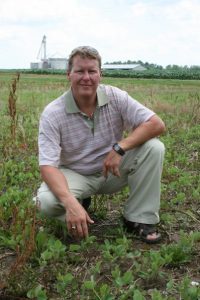Agronomy, Conservation, Homepage Slider
Finding product synergies in a systems approach
By Dusty Sonnenberg, CCA, Ohio Field Leader: a project of the Ohio Soybean Council and soybean checkoff
Every year, farmers typically get the opportunity to attend meetings and hear a national yield contest winner speaking about the systems approach they take on their farm, and the products they use to achieve their record breaking yields. The number of new products coming to market each year to help farmers increase their yield can be overwhelming.
“It seemed like at every trade show I would be inundated by all the companies and the new products they had to offer and ideas how I could incorporate them into my system to gain 3 to 6 bushels per acre,” said John Buck, a farmer from New Bloomington. “Every product offered presents some value and has a fit somewhere. I like to try new things that I think will improve my specific crop production system, and to look for other complimentary products I can include to create synergies.”

Each farms’ unique environment and growing conditions, which would include things such as soil type, drainage, pH and soil test levels, and planned cropping rotation is important to consider.
“Before a farmer tries any new product, they need to be sure to have a current soil test, and have the pH and all the nutrients at the correct levels,” Buck said. “When a farmer is working with any biological product, management will be the key.”
Buck, who farms in Marion and Delaware counties, had over 400 acres of test plots and field trials planned for 2019.
“Unfortunately, because of the weather challenges last spring, several of those trials did not happen. If everything goes well this spring, we will have the same trials and test plots that we planned for last year, and possibly a few more,” Buck said. “We have found that it can take some trial and error to know how a certain product will fit into our system. I have been experimenting for the last five years with different products that I think may have a fit and combine them with the other products I have already incorporated.”
Buck believes that a fit he would like to build on is the use of biologicals in his operation, especially as they can improve and increase the diversity of mycorrhizal fungi in his soils. Mycorrhizal fungi are the “good” fungi that form mutually beneficial relationships with plants. The “relationships” are called mycorrhizae. Mycorrhizal hyphae form mycelium, which is a fungal network that effectively extends a plant’s root system. The Mycorrhiza help the plant reach, break up, and mobilize soil nutrients that would otherwise be unavailable.
Buck has been using a product developed by Groundwork BioAg, an Israeli company.
“When I served on the Ohio Soybean Council, I became affiliated with Groundwork BioAg as a part of the Ohio Israel Ag Initiative (OIAI),” Buck said. “The OIAI is an organization that works to improve trade as well as research and development projects related to agriculture between Ohio and Israel.”
The product, which is trade named Rootella, is a mycorrhizal inoculant developed from vigorous strains of endomycorrhiza (which benefit herbaceous agriculture crops) found on plants in the Israeli desert.
“The Rootella delivers a dominant strain of mycorrhizae that works with the existing native mycorrhizae in my fields,” Buck said.
One benefit to mycorrhizal fungi is that they produce glycoproteins called glomalin. Glomalin is a substance that acts like a glue in the soil that binds organic matter in the soil to the sand, silt and clay particles, and gives soil its tilth. It also adds to soil structure and sequesters atmospheric carbon that comes from the plants connected in the mycorrhizae. Mycorrhizae are also able to dissolve and actively absorb phosphorus (P) and move it into the plants.
“Most plants only absorb about 15% of the P that is in the soil,” Buck said. “If we can utilize more of the P that is already in the soil, that can help increase yields, and also go a long way in reducing potential P runoff when it comes to water quality issues.”

Buck cautions that there are a number of different products in the market that are designed to increase mycorrhizal fungi levels, but the farmer needs to understand what they are buying. “When it comes to mycorrhizal fungi available in the products available, there are both endomycorrhizae and ectomycorrhizae, and the difference is in how they function. It is the endomycorrhiza that a farmer is primarily concerned with and wants for their grain crops,” Buck said.
Concentration of the product is also an important consideration.
“When it comes to mycorrhizae, the cost/benefit of the inoculant actually making a difference in the field really depends on the concentration of mycorrhizae in the product. Mycorrhizae concentration is measured in the number of propagules per gram of product,” Buck said. “It takes about 1 million propagules per acre to get an effective colonization of the mycorrhizae and actually get it to work.”
Another biologic product that Buck has been using in his systems to try to find synergies is from 3Bar Biologics.
“I became familiar with 3Bar Biologics in my time on the Ohio Soybean Council, and it is a company that was formed as a spin-off from work done jointly at The Ohio State University,” Buck said. “I was looking for something that was a biological and had beneficial microbes that would work with the bacteria already in my soil to improve the soil environment in the rhizosphere.”
Buck believes having a healthy rhizosphere helps plants get off to a good start early and sets them up for future success.
“I like to describe benefits to early plant health similar to raising livestock. I tell guys who raise livestock that if a newborn animal starts off weak, or lags behind compared to the rest of the group, it always struggles to keep up, and may never really catch-up fully. Our plants are the same way. If we set them up with a healthy root system and strong plant structure early, they we have something to build upon,” Buck said. “Bio-Yield is a bio-stimulant that contains beneficial microbes. They work as an inoculant to help the plant emerge faster and get off to a healthy start.”
3Bar Biologics has a unique proprietary delivery system that activates and grows the beneficial microbes shortly before use by the farmer. The product can be applied either on the seed, or in-furrow.
“One challenge I run into when using multiple products that are on the market is that each company wants theirs put on the seed as a seed treatment,” Buck said. “The problem is that there is only so much surface area on a seed for all those products. I am looking for other ways to deliver the products in my system so I can get the yield advantage of each of them combined.”
There are other products Buck is going to be trying that he hopes will have a fit in his system. “There is a sea weed extract product which is harvested from plants in the North Atlantic that is a little different than some others on the market. Toggle by Acadian Pant Health is available as both a dry and liquid, and can be used as a seed treatment or for in-furrow, but also can be applied foliar. It is supposed to trigger specific activities within the plant to help overcome stress, primarily caused by our cool and wet spring planting conditions,” Buck said. “When I evaluate these products, I look for synergies. I ask myself if it is working in a way different from the others I am already using. Does it have a different carrier agent? Is it a unique mode of action or delivery mechanism? I am looking for something that can improve the plant’s health naturally so I do not have the need for fungicides and insecticides because the healthy crop is better able to fight off the disease or tolerate the insect pressure.”